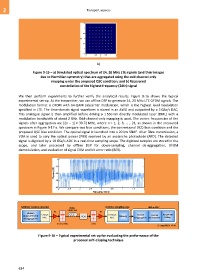Page 624 - 5G Basics - Core Network Aspects
P. 624
2 Transport aspects
b)
Figure 9-15 – a) Simulated optical spectrum of 24, 20 MHz LTE signals (and their images
due to Hermitian symmetry) that are aggregated using the odd-channel-only
mapping under the proposed QSC condition; and b) Recovered
constellation of the highest-frequency (24th) signal
We then perform experiments to further verify the analytical results. Figure 9-16 shows the typical
experimental set-up. At the transmitter, we use offline DSP to generate 24, 20 MHz LTE OFDM signals. The
modulation format is OFDM with 64-QAM subcarrier modulation, which is the highest level modulation
specified in LTE. The time-domain signal waveform is stored in an AWG and outputted by a 5 GSa/s DAC.
This analogue signal is then amplified before driving a 1 550 nm directly modulated laser (DML) with a
modulation bandwidth of about 2 GHz. Odd-channel-only mapping is used. The centre frequencies of the
signals after aggregation are (2n − 1) × 30.72 MHz, where n = 1, 2, 3, … , 24, as shown in the measured
spectrum in Figure 9-17-a. We compare two bias conditions, the conventional DCO bias condition and the
proposed QSC bias condition. The optical signal is launched into a 20 km SSMF. After fibre transmission, a
VOA is used to vary the optical power (PRX) received by an avalanche photodiode (APD). The detected
signal is digitized by a 10 GSa/s ADC in a real-time sampling scope. The digitized samples are stored in the
scope, and later processed by offline DSP for down-sampling, channel de-aggregation, OFDM
demodulation, and evaluation of signal EVM and bit error ratio (BER).
Arbitrary waveform generator 20-km Real-time sampling scope Offline DSP
SSMF link
PA PA
Memory
( ignal generations 5-GSa/s VOA 10-GSa/s Memory Channel OFDM EVM/BER
reading
and aggregation) DAC ADC de-aggregation demodulation
2-GHz DML APD
G Suppl.55(15)_F9-16
Figure 9-16 – Typical experimental set-up for evaluating the performance of the
proposed soft-clipping technique
614

